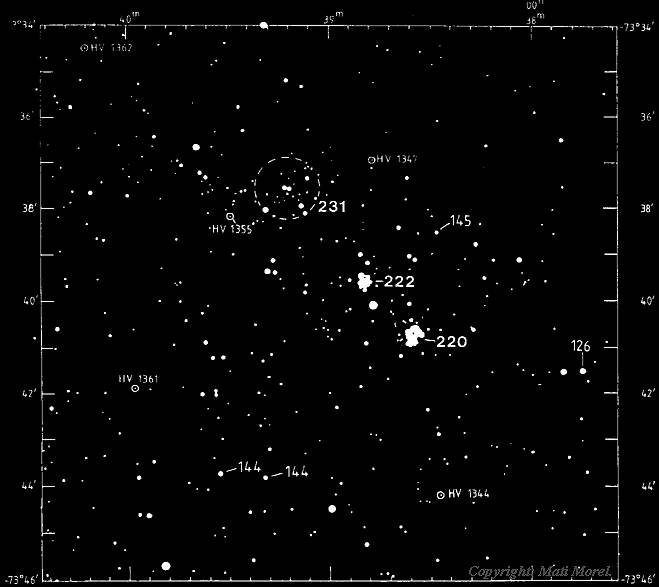BNGC 15. Mati Morel Maps Magellanic Marvels
Back to Index of Beyond the NGC
By Steve Mencinsky, 1994
Without wishing to tread on our esteemed Treasurer's toes, this month's BNGC is in the form of a resource review.
Quite a few years ago, Mati Morel announced in this magazine his charts of the Small and Large Magellanic Clouds. Your correspondent acquired both sets and has exhaustively observed both: every listed non-stellar object in the Small Cloud, and perhaps 95 % of the Large Cloud. This month, BNGC will review the Small Cloud; no prizes for guessing that the next BNGC will be a review of the Large Cloud.
 For the price, what one gets seems excellent value for money. In the Small Cloud, there are two Master Charts, each A2 size (twice the width and nearly twice the length of the pages of this magazine); as well as an A4 size booklet containing much reference material and ten detailed area charts.
For the price, what one gets seems excellent value for money. In the Small Cloud, there are two Master Charts, each A2 size (twice the width and nearly twice the length of the pages of this magazine); as well as an A4 size booklet containing much reference material and ten detailed area charts.
Master Chart B is essentially for variable star observers. Hundreds of these are shown. As your correspondent does not list these amongst his current interests, he has never used this chart and will therefore refrain from further comment on it. Master Chart A lists the non-stellar items - NGC, IC and other Clusters; Nebulae and Galaxies; as well as the Named Variable Stars. This is the chart with which your correspondent has worked the most closely.
No matter how much detail is put on a chart, there will be someone who wants more and your correspondent is no exception. From a purely personal point of view, it would have been "nice" if the Master chart had on it the locations of the ten detailed selected areas, and your correspondent has added those himself. Also, in this day and age, it would be nice if the charts used the epoch 2000 coordinate system rather than 1950. A final personal touch: based on an idea first shown by Mick McCullagh, your correspondent has carefully drawn on his SMC-A several circles corresponding to the fields of view of his various eyepieces.
Without a doubt, the feature of SMC-A that your correspondent has found most valuable (from personal observation) is the exhaustive coverage that the charts provide. The foreground star field appears complete all the way down to chart limit of "about" 13. (The area around the core of 47 Tucanae, for what is hopefully an obvious reason, has not been checked in this regard!) With a (say) 10" or 12" telescope, therefore, the stars one sees on the charts match very closely what one sees in a typical wide-angle eyepiece, under a dark sky - (and, conveniently, through a 18" telescope from Cremorne). This makes navigating the chart an absolute 'breeze. 'The non-stellar objects are also extremely well covered - your correspondent with his late 12" scope could find nothing in the SMC that was not in the charts. Even with Johannes, only a fistful of very, very, very, faint and small fuzzies have been added. One suspected variable star has been stumbled upon, but to quote Tony Buckley, that's another story.
The accompanying booklet comprises a wide variety of information, the bulk of which is about the variable scars shown on the charts. The ten detailed charts have 2000 as well as 1950 coordinates. They show the :areas to a much larger scale; include more objects than can be shown on SMC-A; show fainter limiting magnitude (about 16); and list measured magnitudes for many reference stars, in one case down to 15.2 (as is the usual practice, this is shown as 152).
By far the most challenging of these detailed charts is the heart of the Small Cloud, detailed chart two. This half degree square is more than an hour's solid work , requiring one's complete range of eyepieces and filters to observe fully. It was this part of the SMC that was referred to in a previous BNGC, covering the area
The single most beautiful object of the SMC is without a doubt NGC 346, covered on detailed chart 6. Mati has gone to great lengths here, showing two isophote contour lines around this object. Fortunately, the actual visual appearance of NGC 346 is in fact very similar - the "bright" and "faint" parts of the nebula are quite clearly defined and quite sharply delineated.
Together, SMC-A and the Detailed Area charts provide a very comprehensive coverage of the deep-sky objects in and around the SMC. Having occupied an entire observing night with these charts and Johannes from Ilford, your correspondent has found only seven faint fuzzies (and they were VERY faint fuzzies indeed!) not listed on the charts.
The "original" copies of the samples (this page and the cover) that your correspondent received were very readable under dim red light, very clean and crisp (some people seem to never bother to clean the face of their photocopiers; but Mati's charts appear completely unblemished in this regard).
The SMC charts and booklet are available from Morel Astrographics, 18 Elizabeth Cook Drive, Rankin Park, NSW for $17.00. For an extra $8.00 is available a recent new feature: colour-coded and laminated Master A and B Charts. Morel Astrographics is a non-profit organization.


